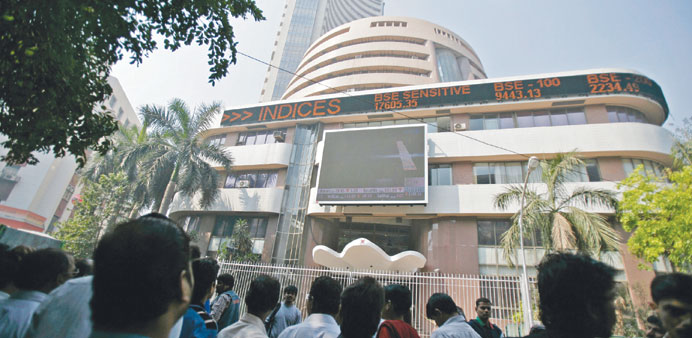|
|
Indian stocks dropped the most in a year as some investors judged the recent rally as excessive and after data showed the nation’s trade deficit widened in April.
The S&P BSE Sensex tumbled 2.1% to 19,691.67 at the close in Mumbai, with volumes 22% less than the 30-day average. All 30 stocks on the index dropped. ITC, India’s biggest cigarette maker, plunged 5.2%, contributing more than a third of the index’s loss. Engineering company Larsen & Toubro slid 3%.
The Sensex closed at its highest level since January 2011 on May 11 as central banks from India to Europe eased monetary policy. The rally drove up the gauge’s valuation to 13.9 times projected 12-month earnings that day, the highest this year.
“The rally was ahead of fundamentals and a correction was due,” Kaushik Dani, a Mumbai-based fund manager with Peerless Mutual Fund, which has about $870mn in assets, said by phone. The recent gains “have only been on the back of good inflows and strong global markets.”
Foreign investors bought $108mn of local shares on May 10, taking this year’s inflows to a net $12.6bn, data from the regulator show. While the Reserve Bank of India pared interest rates at its May 3 review, Governor Duvvuri Subbarao said the shortfall in the current account, the broadest measure of trade, limits room for further reductions.
ITC plunged 5.2% to Rs335.8, its steepest fall since September 17. The stock, with the biggest weighting on the Sensex, closed at a record for five straight days through May 11. Its 14-day relative strength index reached 79.5 on May 11, the highest in more than a year. Some investors see readings above 70 as a signal to sell.
Hindustan Unilever, India’s biggest home-products maker, fell 0.7% to Rs582.2. The stock closed at a record Rs587 on May 8. The S&P BSE Fast-Moving Consumer Goods index slid 3.2%, the most since September 17.
Tata Consultancy Services, India’s largest software exporter, lost 2.6% to Rs1,451.6. Mortgage lender Housing Development Finance Corp lost 1.3% to Rs863.5, a fourth day of drop from an all-time high reached last week. Larsen & Toubro decreased 3% to Rs1,517.4 and Bharat Heavy Electricals, the nation’s biggest producer of power equipments, fell 2.9% to Rs190.4.
“We’re seeing a correction after a straight run up as index heavyweights are overbought,” Deven Choksey, managing director at K R Choksey Shares & Securities in Mumbai, told Bloomberg TV India yesterday. “Traders booked profits in counters where long positions were created.”
Investor sentiment was also dented after earnings at some companies outside the benchmark indexes trailed estimates.
Nestle India, the local unit of the world’s largest food company, declined 1.1% to Rs4,848.2 after its first-quarter profit lagged behind estimates. Lender Bank of India plunged 4.5% to Rs324.25 after its net income dropped 20%. Bank of Baroda shed 1.9% to Rs690.05 after quarterly earnings declined 32%.
Profits at just two of the 14 Sensex companies that have reported March-quarter earnings have trailed estimates. That compares with about 43% that missed forecasts in the three months ended Dec. 31, and 40% in the previous two quarters.
The 50-stock CNX Nifty Index lost 2.1% to 5,980.45, retreating from its highest level since Jan. 4, 2011. Its May futures settled at 5,994.45. India VIX, which gauges the cost of protection against losses in the Nifty, surged 4%.
Meanwhile, India’s rupee rebounded from a 10- week low after the central bank tightened rules on gold imports. Government bonds were steady.
The Reserve Bank of India today said it would immediately restrict shipments of gold on consignment basis by banks only to meet “genuine” needs of jewelry exporters. The rupee had weakened earlier on speculation bullion importers are stepping up dollar purchases today on Akshaya Tritiya, a festival on which it is considered auspicious to buy the metal.
The rupee advanced 0.1% to 54.7350 per dollar in Mumbai. It touched 55.0250 earlier, the weakest level since March 4.
“The RBI restriction was a big positive,” said Sudarshan Bhatt, chief currency trader at state-run Corp Bank in Mumbai. “Exporters also sold the dollar at around 55.”
Demand for gold in the world’s largest importer of the commodity is seen at 30 metric tonnes yesterday, compared with 20 tons a year ago, said Prithviraj Kothari, managing director of Riddisiddhi Bullions in Mumbai.
One-month implied volatility in the rupee, a gauge of expected moves in the exchange rate used to price options, rose 35 basis points, or 0.35 percentage point, to 8.62%.
The rupee was also pressured and bonds briefly fell after official data yesterday showed the trade deficit widened last month to $17.8bn as gold imports surged 138% from a year earlier. The shortfall in the current account, the broadest measure of trade, limits room for further interest-rate cuts, central bank Governor Duvvuri Subbarao said on May 3.
This countered optimism stemming from another government report that showed consumer prices rose 9.39% in April, less than a 9.74% increase forecast by economists in a Bloomberg survey. Wholesale price inflation probably slowed to 5.45% in April from a year earlier, after a 5.96% increase in March that was the least since 2009, according to the median estimate of 29 economists in a separate survey before data due tomorrow.
The yield on the 8.15% bonds due June 2022 was little changed from May 10 at 7.59%, according to the central bank’s trading system. That is the lowest level for a benchmark 10-year note since July 2010.
Three-month onshore rupee forwards traded at 55.74 per dollar, compared with 55.59 on May 10. Offshore non-deliverable contracts were at 55.59 versus 55.57.

